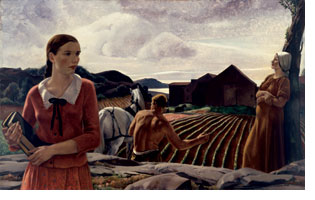Back

Remember the grammar drills and formulaic essays of high
school English? If you were one of many students who dreaded
the hour spent in English class, you might find Carnegie
Museum of Art’s new approach to learning English
inspiring. Art & Writing, the new 90-minute gallery
program, uses firsthand encounters with art to inspire
creative writing. Developed in collaboration with educators
and docents from Carnegie Museum of Art and English teachers
from Bethel Park High School and launched at the start
of the 2005 school season, it has teachers talking. And
students writing.
“
If you’ve ever experienced writer’s block,
this program is the ultimate cure,” Leigh Ann Totty
told her class of creative writing students at Bethel Park
High School. “You’ll find endless characters,
settings, and plots just waiting to enter your stories.”
To
Totty and other English teachers in the western Pennsylvania
region, the museum’s program is a dream come true.
Not only does it make writing less intimidating and more
fun than the expository writing exercises that dominate
the English curriculum, it also gives students something
authentic to write about.
Says Carnegie Museum of Art’s
Curator of Education Marilyn Russell: “Art is something
about which students can form an opinion and develop a
response. It’s
full of deeply held beliefs that inspire genuine questions
about life and the human experience. Students need these
things to become good writers. They need to have something
to say.”
Like other school tours offered by Carnegie
Museum of Art, Art & Writing encourages students to
look closely at art while sharing ideas about what they
see. Unlike other
tours, Art & Writing has less to do with historical
context and more to do with imagination.
Encouraged to
put aside factual information they know about the art,
museum docents prod students to use their imaginations
to create story ideas inspired by what they see.
 “
Let’s look at the young girl in the painting, the
one holding the books,” says docent Merle Culley
to a group of eighth graders standing in front of the painting
Morning on the Cape (1935) by American artist Leon Kroll. “What’s
going through her mind?” “
Let’s look at the young girl in the painting, the
one holding the books,” says docent Merle Culley
to a group of eighth graders standing in front of the painting
Morning on the Cape (1935) by American artist Leon Kroll. “What’s
going through her mind?”
“
I think she’s sad because she doesn’t want
to leave the farm. She doesn’t want to go to school,” one
student says.
“
No way,” someone else interjects. “I think
she’s bored with the farm. Just look at her face.
She looks like she’s dreaming of a life far away,
a life in a big city, maybe. Her fancy clothes don’t
fit in with the farm.”
“
I’m not so sure,” a student from the back row
says. “To me, she’s not really bored with the
farm or sad to leave it. She’s dreaming of her future.
Maybe she’s in love with a boy who left for the war,
and she’s imagining life when he returns. She’s
looking at the pregnant lady, so maybe she’s dreaming
of having her own baby.”
In a discussion that sounds
more introspective than one might expect from eighth graders,
the students offset each
other’s ideas with visual evidence from the painting,
much like a detective at a crime scene. The young girl’s
glance away from the farm indicates a plan of escape, not
a sign of contentment. Her well-groomed hair and collared
shirt suggest wealth, not poverty. And the two people in
the background, positioned in close proximity to the farm,
represent an old way of life soon to be replaced by modernization.
These insights, which students share out loud and jot
down in journals, form the basis of narrative stories completed
back in the classroom. Stories range from Medieval and
modern romances to snippets of daily life, complex dramas,
and works of historical fiction.
According to Kathleen
Antonazzo, a language arts teacher at Saints Peter and
Paul School, Art & Writing inspired
such a wide range of stories that it became not just a
lesson in writing but also a lesson in tolerance of multiple
perspectives. “The fact that students extracted such
different ideas from the same works of art made them more
open-minded and accepting of different viewpoints. They
ultimately learned that there’s more than one way
to look at something.”
While Art & Writing provides
a breath of fresh air for English teachers and students,
it also supports the
educational objectives of schools, which prioritize writing
as an essential part of learning in all academic subjects.
“
To the extent that we can be of service to the needs of
teachers and students, we want to do as much as we can
to help,” Russell explains. “With galleries
full of original art from distant time periods and places,
the museum is a perfect place for enhancing exactly what
schools need to develop—speaking and writing skills,
critical thinking, reasoning, creativity, and tolerance.”
From
the thoughtful observations articulated in the galleries
to the polished stories produced in the classroom, Art & Writing
offers a fresh approach that makes students eager to write. “Kids
are your toughest critic,” says Freedom Area High
School teacher Susan Rigotti. “The fact that Art & Writing
held my students’ attention speaks volumes about
the program.” And it keeps them writing volumes,
too.
Teachers interested in learning
more about innovative techniques to help make their students
better communicators can participate
in an Art & Writing workshop at Carnegie Museum of Art
on July 26. For information call 412.622.3288 or visit www.cmoa.org.
Back
| Top |